
3rd Issue 2007
Feature Articles
(I) Guangdong, Hong Kong, Shenzhen, Zhuhai, Macao Health, Animal and Plant Quarantine and Food Safety Control Meeting
The two-day Guangdong, Hong Kong, Shenzhen, Zhuhai, Macao Health, Animal and Plant Quarantine and Food Safety Control Meeting was held in the Hong Kong Convention and Exhibition Centre on 21 and 22 June to further promote the co-operation of the five places in health, animal and plant quarantine and food safety through exchange and discussion among experts.
Speaking at the opening of the Meeting, the then Secretary for Health, Welfare and Food, Dr York Chow, pointed out that Guangdong, Shenzhen, Zhuhai, Macau and Hong Kong were close neighbours with heavy volume of passenger and freight flow between these places. With further regional economic development, the health, inspection and quarantine authorities in the Mainland, Macau and Hong Kong had to further strengthen cooperation on this front. He expected that through exchange among experts, the technical standard of health, animal and plant quarantine and food safety could be raised to facilitate the implementation of health and food safety regulatory measures and further refinement of the existing co-operation mechanism and information exchange.
 Topics of discussion in the Meeting included inspection and quarantine on health, fruits and vegetables, aquatic products, plants, animal and food livestock as well as the management of food safety of poultry eggs, laboratory standard and technology.
Topics of discussion in the Meeting included inspection and quarantine on health, fruits and vegetables, aquatic products, plants, animal and food livestock as well as the management of food safety of poultry eggs, laboratory standard and technology.
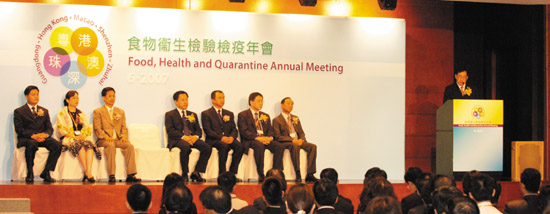
The Hong Kong delegation was represented by the then acting Permanent Secretary for Health, Welfare and Food, Mr Cheuk Wing-hing; the Director of Food and Environmental Hygiene, Mr Eddy Chan; the Controller of Centre for Food Safety, Dr Mak Sin-ping; and representatives from other Government departments. Also joining the meeting were the Director-General of the Import and Export Food Safety Bureau of the State General Administration of Quality Supervision, Inspection and Quarantine (AQSIQ), Mr Li Yuanping; Deputy Director General of the Guangdong Entry-Exit Inspection and Quarantine Bureau, Dr Huang Weiming; Deputy Director General of the Shenzhen Entry-Exit Inspection and Quarantine Bureau, Mr Qu Haifeng; Deputy Director General of the Zhuhai Entry-Exit Inspection and Quarantine Bureau, Mr He Hongkai; and Vice Chair-Woman, Administration Committee, Civic Municipal Affairs Bureau of the Macao Special Administrative Region Government, Ms Cecilia Cheung.
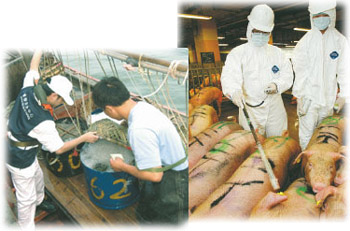
(II) Microbiological Guidelines for Ready-to-eat Food
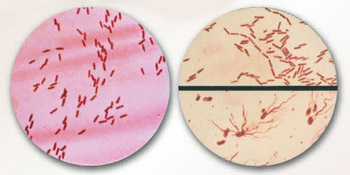 According to the Codex Alimentarius Commission, an international food standard setting authority, the functions of microbiological guidelines include setting of the design requirements of food premises, indication of the required and expected microbiological status of food commodities, and verification of the efficacy of the hygienic practices adopted.
According to the Codex Alimentarius Commission, an international food standard setting authority, the functions of microbiological guidelines include setting of the design requirements of food premises, indication of the required and expected microbiological status of food commodities, and verification of the efficacy of the hygienic practices adopted.
In 2002, the Food and Environmental Hygiene Department, upon the advice of the Expert Panel on Microbiological Safety of Food, developed the Microbiological Guidelines for Ready-to-eat Food (the Guidelines). The Guidelines stipulate the safety limits of nine major food borne pathogens such as Salmonella species, Listeria monocytogenes, E. coli O157 and Vibrio cholerae, and provide a classification of the microbiological quality of ready-to-eat food to reflect the hygienic status of the food concerned.
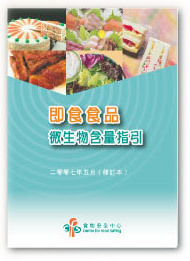 In light of changing needs and with reference to the latest expert views, the Centre for Food Safety (CFS) revised the Guidelines in 2007. The revision mainly involves textual amendments and update of the microbiological limits for Listeria monocytogenes according to international practices and risk assessment results.
In light of changing needs and with reference to the latest expert views, the Centre for Food Safety (CFS) revised the Guidelines in 2007. The revision mainly involves textual amendments and update of the microbiological limits for Listeria monocytogenes according to international practices and risk assessment results.
With the microbiological limits of ready-to-eat food explicitly set, the food trade can draw up relevant food safety control plans and focus on the implementation of priority control measures. The Guidelines can also assist regulatory authorities to monitor and control food safety.
Cooperation among the food trade, the public and the government is essential in ensuring food safety. With better knowledge on the microbiological safety of ready-to-eat food, the trade can further enhance the standards of their food hygiene practices. The CFS hopes that the revised Guidelines can meet their needs.
For details of the Guidelines, please go to the CFS website:
http://www.cfs.gov.hk/english/whatsnew/whatsnew_act/files/MBGL_RTE%20food_e.pdf
(III) What is Formaldehyde?
Formaldehyde, a chemical, is a colourless gas at room temperature and highly soluble in water with a strong irritating smell. It can be used as industrial disinfectant, as raw material in plastic manufacturing and as embalming agent. Formaldehyde is sometimes added inappropriately in food processing for its preservative and bleaching effects.
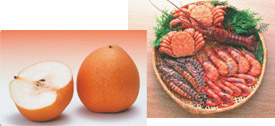
However, this chemical also occurs naturally in the environment. As a metabolic intermediate, formaldehyde is present at low levels in most living organisms. Formaldehyde can be found naturally in food, including fruits and vegetables (e.g. pear, apple, green onion), meats, fish (e.g., Bombay-duck, cod fish), crustacean and dried mushroom, etc, up to the levels of 300 to 400 mg/kg.
In some seafood species such as Bombay-duck, formaldehyde is a natural breakdown product of a chemical known as trimethylamine oxidase (TMAO) that exists in their bodies. TMAO breaks down into formaldehyde and dimethylamine in equal parts after the death of the marine organisms. The level of formaldehyde can accumulate in certain marine fish during frozen storage and in some crustacea after death. The level was reported to be up to 400 mg/kg in Bombay-duck after cold-storage. The detection of dimethylamine in Bombay-duck was used to distinguish whether formaldehyde had been deliberately added. For noodlefish, in the absence of dimethylamine, the detection of formaldehyde (160 to 620 mg/kg) in some noodlefish samples indicated that formaldehyde might have been added as a preservative after the noodlefish were caught, or during transportation or storage.

The World Health Organization (WHO) has established a Tolerable Daily Intake (TDI) of 0.15mg/kg body weight for this chemical. The TDI is the estimated amount of a substance that can be ingested daily (on body weight basis) over a lifetime without appreciable risk. Ingestion of a small amount of formaldehyde is unlikely to cause any acute effect. Acute toxicity after ingestion of large amount can cause severe abdominal pain, vomiting, coma, kidney injury and possibly death. However, the general population is exposed to formaldehyde mainly by inhalation.
The main health concern of formaldehyde is its cancer causing potential. The International Agency for Research on Cancer (IARC) considered that there was sufficient evidence for carcinogenicity in humans upon occupational exposure via inhalation. On the other hand, WHO in 2005 when setting its Drinking Water Guidelines considered that there was no definitive evidence for carcinogenicity upon ingestion.
Food for sale in the HKSAR must be fit for human consumption as stipulated in the Public Health and Municipal Services Ordinance, Cap. 132. The use of prohibited preservatives such as formaldehyde contravenes the Preservatives in Food Regulations and is liable to a maximum fine of HK$50,000 and imprisonment for 6 months. For foods containing natural formaldehyde, there is no international consensus reference on their levels. The testing of formaldehyde in food is included in our food surveillance programme. Follow-up action will be undertaken when there is suspected abuse of formaldehyde in foods.
Advice to Consumers
-
Patronise reliable food premises and food retailers, both in Hong Kong and abroad.
-
Choose fish that are fresh with no unusual smell, and avoid buying the stiff ones as formaldehyde can stiffen the fish.
-
Wash and cook food products thoroughly since formaldehyde is water soluble and will dissipate upon heating.
-
Maintain a balanced diet to avoid excessive intake of food chemicals from a small range of food items.
(IV) Allergens in Food
- What is food allergy?
Food allergy is an abnormal response to a food substance, usually a protein, by one's body immune system. Common symptoms include skin irritations (e.g. rashes), gastrointestinal symptoms (e.g. nausea, diarrhoea and vomiting), sneezing and shortness of breath. Furthermore, sulphiting agents which can be used in food as preservatives may cause asthma in asthmatic patients or people with allergic conditions. The symptoms and severity vary among individuals. Symptoms typically appear within minutes to an hour after eating, and can last for days and even weeks.
- What are food allergens?
Food allergens are the foods that cause an allergy. The most common food allergens are milk, eggs, peanuts, tree nuts, soy, wheat, fish and shellfish, as well as foods containing sulphite in a concentration of 10 parts per million or more. They account for more than 90% of all food allergic reactions. However, many other foods have been identified as allergens for some people. - Do I have food allergy?
Some people suffer from diarrhoea every time after drinking milk, but they may not be allergic to milk. It can be due to the lack of an enzyme that is needed to digest milk sugar. In fact, of all the individuals who have adverse reactions to certain foods, only few have true food allergies. The World Health Organization estimates that around 1-3% of adults and 4-6% of children suffer from food allergies. One should seek medical advice if an adverse reaction to a certain food is suspected. - Why should food allergens be labelled?
Currently, there is no cure for food allergy. A severe food allergy can be life-threatening. Strict avoidance of the allergy-causing food is the only way to avoid a reaction. Individuals with food allergies need to rely on an accurate food label to choose food. Thus, the labelling of allergens in food is important and necessary. - What allergens must be labelled under the regulations?
The Food and Drugs (Composition and Labelling) Regulations require that the names of the following known allergens present in a prepackaged food must be specified in the ingredient list:
-
cereals containing gluten (namely wheat, rye, barley, oats, spelt, their hybridized strains and their products);
-
crustacea and crustacean products;
-
eggs and egg products;
-
fish and fish products;
-
peanuts, soybeans and their products;
-
milk and milk products (including lactose);
-
tree nuts and nut products.
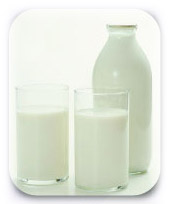
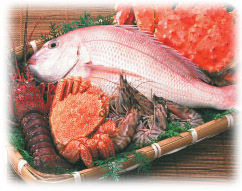
In addition, if a food consists of or contains sulphite in a concentration of 10 parts per million or more, the functional class of the sulphite and its name shall be specified in the list of ingredients.
The above requirement was enacted in July 2004 and the three-year grace period lapsed on 9 July 2007.
- How do the labels of allergens look like?
If a food contains those food allergens specified in law as ingredients, these allergens are labelled in the ingredient list in the same way as any other ingredients. All ingredients are labelled in descending order of their weights or volumes.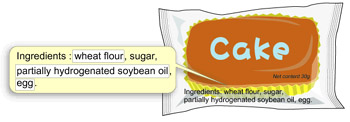
When an ingredient, by its name, is not easily identified by consumers as an allergen, supplementary information is added next to its name.
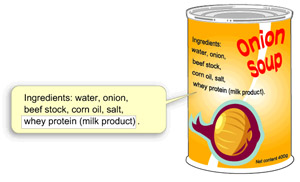
In some food products, no allergen is used as an ingredient, but these products are produced on a production line with other products containing an allergen or in a factory where an allergen specified in law is handled. Manufacturers should take precautions to prevent products from being contaminated by allergens. If after taking all reasonable precautions, the chance of cross-contamination still cannot be ruled out, manufacturers can put a warning statement next to the ingredient list.

- What should people suffering from food allergies note?
People suffering from food allergies should read food labels carefully when purchasing food and ask the suppliers for further information if in doubt about the food composition. When eating out, explain your situation and needs clearly to the food providers. If feeling unwell after eating, seek medical treatment immediately.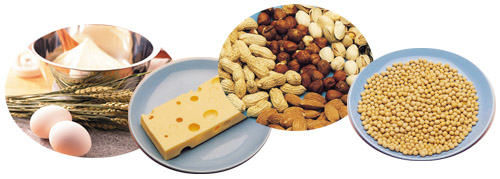
For additional information on labelling of food allergens, please visit the website of the Centre for Food Safety: www.cfs.gov.hk
Readers' Corner
(I) Food Research Laboratory
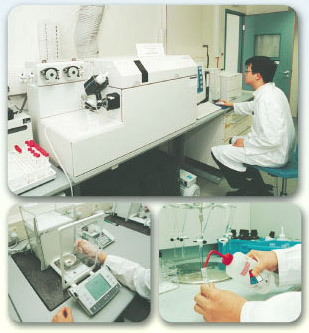 Introduction
Introduction
In view of the increasing sophistication in the food production process and the advancement in food science, the WHO advocates a risk-based and proactive food safety control model with sound scientific basis to cope with the changing needs of the community. In line with the WHO's food safety model and as part of the Government's efforts to strengthen the scientific basis of the food safety control work, the Food and Environmental Hygiene Department (FEHD) has established the Food Research Laboratory (FRL) under the Centre for Food Safety (CFS).
Roles and Scope of Work
FRL provides dedicated laboratory and research services on locally available foods to support CFS in:
- dietary exposure studies to get an overview of the safety of food supply;
- risk assessments of food hazards and setting of food standards; and
- nutritional assessments of local indigenous foods, with information available for public access through the Nutrient Information Inquiry System
(http://www.cfs.gov.hk/english/nutrient/index.shtml) on the CFS website.
Findings of the studies also enable CFS to take suitable measures in strengthening food safety control and safeguarding public health, including:
- planning and formulation of appropriate food safety control measures;
- legislative reviews to cope with the rapid development in food science and technology; and
- launching of publicity programmes to educate the public ways to reduce food risks.
Facilities
The 600m 2 FRL consists of laboratory areas and instrument rooms. It is equipped with an array of sophisticated state-of-the-art analytical instruments, including:
- Inductively coupled plasma high resolution mass spectrometer for determination of trace metals and nutritional elements in food;
- Gas chromatograph – high resolution mass spectrometer and liquid chromatograph – tandem mass spectrometer for qualitative and quantitative analysis of organic nutrients, additives and contaminants in food.
(II) Proper handling of vegetables
Vegetables are essential component of a balanced diet and good sources of dietary fibre, vitamins and minerals, which not only promote gastrointestinal health, but also reduce exposure to the risks of some chronic diseases (including cancer and cardiovascular diseases).

Pesticides are substances used to kill or control unwanted insects, plants, fungi, rodents or other pests. Insecticides, herbicides, rodenticides and fungicides are some commonly used pesticides. Proper use of pesticides can reduce the harmful effects of pests and fungi on crops, reduce soil erosion caused by weeding and increase crop yield. As a result, there are more reasonably priced vegetables which are wholesome, free of pests and harmful substances available in the market, and consumers' health and living quality are thereby enhanced. However, if pesticides are used improperly, consumers may ingest excessive amount of pesticide residues which will affect their health.
Probable reasons for excessive pesticide residues in vegetables
-
Direct or excessive use of pesticides on vegetables;
-
Insufficient time for pesticides to decompose to a safe level before harvest;
-
Environmental contamination.
Acute food poisoning symptoms caused by pesticides include vomiting, diarrhoea, abdominal pain, dizziness and numbness. In severe cases, the victims may even have difficulties in breathing, blurred vision and convulsion. Chronic poisoning may damage the nervous system or other organs such as liver and kidneys. Some pesticides may be transferred via the placenta or by breast milk and affect the development of the foetus or baby.
Pesticide contamination is commonly found in leafy vegetables such as Chinese flowering cabbage, Chinese lettuce, Indian lettuce, water cress and cauliflower.
Monitoring and Control of Vegetables on Sale in Hong Kong
The CFS of FEHD carries out a Food Surveillance Programme and regularly takes samples of vegetables at import, wholesale and retail levels for testing.
Most of the vegetables on sale in Hong Kong come from the Mainland. All vegetables imported from the Mainland must come from registered farms or purchasing stations under the supervision of the Mainland monitoring authorities. CFS has a Food Control Office in Man Kam To. When vegetables reach Man Kam To, CFS checks relevant documents including Pesticide Declaration Certificate, Monitoring Card etc. Random samples of vegetables will be collected for testing of pesticide residues at the Man Kam To Food Laboratory whenever necessary. Furthermore, CFS collects vegetable samples at the wholesale and retail levels for testing of pesticide residue in the Government Laboratory. Some samples are tested for heavy metals.
CFS refers to the Maximum Residue Limits (MRLs) recommended by Codex Alimentarius Commission in determining whether vegetables contain excessive pesticide residues. MRL is the maximum concentration of a pesticide residue permitted in a food commodity when the Good Agricultural Practice (GAP) is observed. GAP provides that the trade should use the least practicable concentration of permitted pesticides for pest control to safeguard consumers' health. The primary aim of setting MRLs for pesticides in food is to safeguard public health and provides an indicator for the trade.
Foods containing pesticides below MRLs are considered wholesome and fit for human consumption. However, pesticide residue levels exceeding the MRL does not necessarily mean that there is an immediate health risk and there is no cause for undue alarm. It reflects improper use of pesticide or contamination of vegetables and rectification at source is required.
Advice to the Public
-
To reduce health risk due to consumption of vegetables contaminated by pesticide, vegetables should be washed under running water several times before soaking for one hour. Alternatively, vegetables may be blanched in boiling water for one minute before cooking. The water used for blanching should be discarded. Take both steps to reduce the risk.
-
To further reduce the intake of pesticides, peel or remove the outer leaves of the vegetables.
-
Vegetables are essential component of a healthy diet. Maintain a balanced diet and eat different kinds of fruits and vegetables to avoid excessive exposure to contaminants from a small range of food items.
-
If discomfort occurs after consumption of vegetables, seek medical advice immediately.
Food Safety Plan Corner
Critical Control Point of Sandwich Making
Sandwich is children's favorite. Many parents like to make sandwich for their children for breakfast or tea. Sandwich is easy to make, just put any filling, such as poultry, meat, seafood, egg and vegetables, between two pieces of bread, and then add dressing.
As the making of sandwich generally involves several steps all done by hand and most sandwiches will not be reheated before consumption, food safety risk is largely increased if the food is not handled properly. To ensure safe consumption, the public should control the critical control points during the process. Take for example the making of club sandwich:
Club Sandwich (serves two)
| Ingredients | Bread | 4 pieces |
|---|---|---|
| Tomato | 70 gram | |
| Eggs | 2 | |
| Bacon | 2 slices | |
| Cheese | 2 slices | |
| Salad dressing | 15 gram |
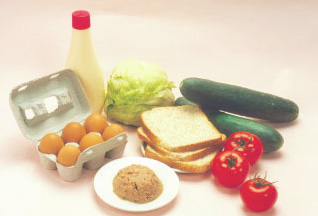
Production Process
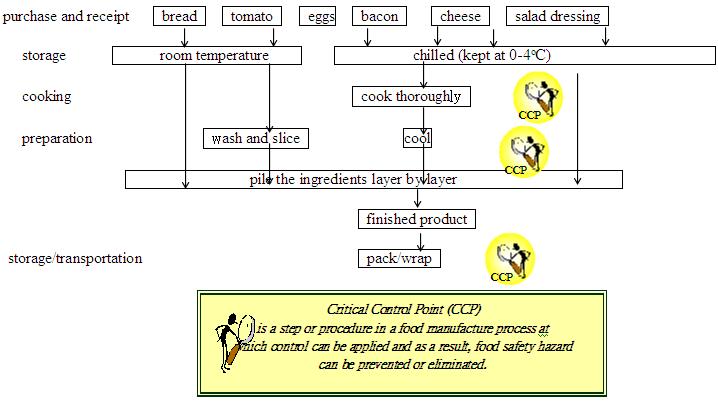
Guidelines on Sandwich Production
- Purchase and receipt
- Check that the ingredients are not contaminated or damaged and they have not passed the "expiry" or "best before" date.
- If canned fish is used, choose the appropriate size to avoid large amount of histamine formed in the canned fish after opening which may lead to histamine poisoning.
 Storage
Storage
- Store the ingredients immediately at proper temperature.
- Practice first-in-first-out stock rotation method.
- Store raw and ready-to-eat ingredients separately.
- Preparation/cooking/cooling
-
Ingredients (e.g. eggs, chicken meat and beef) that need cooking have to be cooked thoroughly until the core temperature reaches 75 °C or above for 30 seconds. (CCP)
-
Cool the food as soon as possible: from 60 °C to 20 °C in two hours and to 4 °C in the next four hours. (CCP)
-
Use separate utensils to handle ready-to-eat and raw foods to avoid cross-contamination.
-
Do not keep at room temperature too much sandwich fillings that are to be served cold and dressings after the jars are opened. Fillings and dressings should be covered and kept at 4 °C or below, and consumed as soon as possible.
-
- Storage/transportation
All finished products that are not consumed immediately should be kept at 4 °C or below if they are to be served cold, and at 60 °C or above if they are to be served hot. Under no circumstances should they be kept at room temperature for more than two hours. (CCP)
Food News
Understanding Trans Fats
Trans fatty acids (also known as "trans fats") are unsaturated fatty acids with at least one double bond in the trans configuration. A low level of trans fats can be found naturally in food (e.g. in the milk and the fat of sheep and cattle). However, in most cases, trans fats are produced during food processing. Trans fats are made when food manufacturers turn oil from liquid form into semi-solid form so as to increase the shelf life and improve the texture of food, such as in the production of hydrogenated vegetable oil, like shortening and margarines. The process is called "hydrogenation".

Foods made with hydrogenated vegetable oil or used in the cooking process are the main sources of trans fats in our diet. Examples are margarines, biscuits, cakes, puff pastries, salad dressings, dried/powdered non-diary creamers and French fries, etc.
Like the saturated fatty acids (also known as "saturated fats") which we are more familiar with, trans fats can raise the level of low-density lipoprotein (LDL) cholesterol (often-called "bad" cholesterol) of our body while at the same time lower the level of high-density lipoprotein (HDL) cholesterol (often called "good" cholesterol), which increases the risk of heart disease. To maintain a healthy diet, we should choose food which contains low levels of saturated fats and trans fats.
According to the recommendation of the World Health Organization, the intake of trans fats should be kept to a minimum - that is less than 1% of daily energy intake. For an individual whose daily energy intake is 2 000 calories, the daily intake of trans fats should be less than 2.2g.
 To reduce the intake of trans fats, the public should:
To reduce the intake of trans fats, the public should:
-
limit the intake of foods made with hydrogenated vegetable oil, shortening or margarine (particularly bakery products).
-
When purchasing pre-packaged foods, read the list of ingredients for relevant information.
-
choose the softer products when selecting margarines.
-
cook or prepare foods using oil with a higher level of monounsaturated fatty acids (e.g. olive oil, canola oil) or polyunsaturated fatty acids (e.g. corn oil, sunflower seed oil).
-
maintain a balanced diet and consume less fried foods.
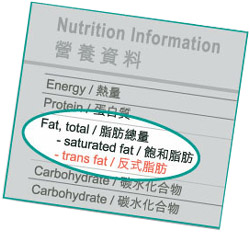
Activities
(I) Consumer Liaison Group
 The Consumer Liasion Group has held nine focus group meetings since its establishment in August 2006. This face-to-face platform enables the CFS to understand better people's knowledge of food safety and to communicate to them various food safety issues. The topics covered at the latest focus group meeting held on 15 June were "effectiveness of health message dissemination in CFS website and the Consumer Guide to Food Additives"
The Consumer Liasion Group has held nine focus group meetings since its establishment in August 2006. This face-to-face platform enables the CFS to understand better people's knowledge of food safety and to communicate to them various food safety issues. The topics covered at the latest focus group meeting held on 15 June were "effectiveness of health message dissemination in CFS website and the Consumer Guide to Food Additives"
 Members participated actively at the focus group meeting and were eager to express their ideas:
Members participated actively at the focus group meeting and were eager to express their ideas:
Member Ms WONG:
-
The website had good design and clear instructions
Member Mr TSANG: -
More information on food additives should be provided in the Consumer Guide to Food Additives
Member Mr CHAN: -
More focus group meetings should be held to enhance the communication between the public and the Government
For more details of the discussion at the meeting, please go to:
http://www.cfs.gov.hk/english/committee/committee_clg.html
(II) Food Safety Day
CFS and the Radio Television Hong Kong jointly organized the Food Safety Day 2007 – "Collective Responsibilities in Ensuring Food Safety" on 18 August at Lung Cheung Mall , Wong Tai Sin. Dr York Chow, Secretary for Food and Health, officiated the event. Featuring singer performance, game booths and exhibition, the event aimed at promoting the collective efforts of the Government, the food trade and the public in ensuring food safety, as well as enhancing the knowledge and skills of the public and the trade on food safety and prevention of unwholesome food.


Interpretation of Ordinance
Importation, manufacture and sale of frozen confections in Hong Kong are regulated by Part V (Food and Drugs) of the Public Health and Municipal Services Ordinance (Cap. 132). According to the Frozen Confections Regulation, a subsidiary legislation of the Ordinance, no person shall sell, for human consumption, any frozen confection unless with the permission in writing granted by the Director of Food and Environmental Hygiene (the Director). Besides, no person shall manufacture any frozen confection unless with a licence granted by the Director and in such premises as shall be specified in such licence. Under the legislation, any frozen confection for sale shall not contain more than 50 000 bacteria or 100 coliform organisms per gram. Frozen confections shall not be kept at a temperature which exceeds -2 degrees Celsius. Any person who contravenes any of the above regulations shall be guilty of an offence, and shall on conviction be liable to a maximum penalty of $50,000 and imprisonment for 6 months.